
Kyoto: Golden Pavilion, Zen Gardens & Historic Temples
Imperial Capital's Temples and Gardens
About This Site
Japan's imperial court established Kyoto as capital in 794, creating a cultural center that developed distinctive Japanese aesthetic principles over eleven centuries through temples, shrines, and gardens. Shogun Ashikaga Yoshimitsu constructed the golden-sheathed Kinkaku-ji pavilion in 1397 as a retirement villa demonstrating the fusion of aristocratic and Zen Buddhist aesthetics, while Zen monks created Ryōan-ji's minimalist rock garden during the Muromachi period to inspire contemplation through precise spatial relationships. These seventeen historic monuments showcase the evolution of Japanese wooden architecture from Heian aristocratic villas like the 11th-century Byōdō-in Phoenix Hall through Zen temples to Tokugawa shogunate power displayed in Nijo Castle, miraculously preserved after Kyoto was spared from World War II bombing.
Why It Matters
Kyoto demonstrates outstanding universal value through exceptional collection of monuments representing thousand years of Japanese architectural and garden design evolution. The seventeen properties exemplify cultural interchange between China and Japan while showcasing indigenous development of distinctive Japanese aesthetic principles that profoundly influenced East Asian culture and worldwide landscape design.
Planning Your Trip
Essential information for visiting this destination
Getting There
Kansai International Airport near Osaka provides international gateway with Haruka Express trains reaching Kyoto Station in 75 minutes offering comfortable reserved seating, while limousine buses offer alternative transfers with luggage space. Shinkansen bullet trains connect Tokyo to Kyoto in 2 hours 15 minutes, with frequent departures throughout the day serving Japan's major cities. Within Kyoto, extensive bus network covers all UNESCO sites, while subway lines serve central areas. Kyoto City Bus Pass provides unlimited daily transportation representing excellent value for temple exploration.
Where to Stay
Central Kyoto Station area offers modern hotels with convenient access to transportation, shopping, and dining, providing practical base for first-time visitors. International chains and Japanese business hotels deliver reliable comfort though lacking traditional atmosphere. Gion and Higashiyama historic districts feature traditional ryokan inns with tatami mat rooms, futon bedding, and kaiseki multi-course dinners, delivering authentic Japanese hospitality. Premium pricing reflects cultural experience and prime location near temples and geisha districts. Arashiyama western area provides peaceful setting near bamboo groves and temples away from central crowds, with mid-range accommodation balancing atmosphere and accessibility. Scenic riverside location offers different Kyoto perspective while requiring longer transport times to eastern temples.
Where to Eat
Kyoto kaiseki cuisine represents pinnacle of Japanese culinary arts through seasonal multi-course meals emphasizing presentation, local ingredients, and subtle flavors developed over centuries of refinement. Nishiki Market showcases regional specialities including yuba tofu skin, tsukemono pickles, and matcha sweets in vibrant food stalls creating atmospheric shopping experiences. Traditional machiya townhouse restaurants serve obanzai home-style cooking while modern establishments offer contemporary interpretations balancing innovation with tradition. Vegetarian shojin ryori Buddhist temple cuisine reflects Zen principles through simple yet refined dishes showcasing seasonal ingredients. Tea ceremony experiences in traditional settings provide cultural immersion complementing temple visits while teaching proper etiquette and appreciation.
Things to Do
Individual temple entry fees cost ¥400-600 ($3-4 USD) per site with Kinkaku-ji Golden Pavilion ¥500 ($3.50 USD), Kiyomizu-dera ¥400 ($3 USD), and Ryoan-ji ¥500 ($3.50 USD). Some sites offer advance online booking reducing queuing times during peak cherry blossom and autumn foliage seasons when visitor numbers surge significantly. Budget ¥2,500-4,000 ($17-28 USD) daily for visiting 5-8 temples among seventeen UNESCO properties requiring multiple days for comprehensive exploration. Kyoto City Bus 1-day pass costs ¥700 ($5 USD) providing unlimited travel connecting major temples. Kansai Thru Pass costs ¥4,000-5,500 ($28-38 USD) for 2-3 days covering trains, subways, and buses throughout Kyoto, Osaka, and Nara regions. Geisha district walking tours through Gion's preserved streets cost ¥3,500-6,000 ($24-42 USD) for 2-hour cultural heritage explorations revealing traditional architecture. Private geisha entertainment (ozashiki) costs ¥50,000-100,000 ($350-700 USD) per hour requiring ryokan or tea house arrangements. Maiko makeover experiences cost ¥15,000-25,000 ($105-175 USD) including professional makeup, kimono dressing, and photography sessions. Kimono rental experiences cost ¥3,000-8,000 ($21-56 USD) per day enabling cultural participation immersing visitors in Japanese traditions through authentic dress while exploring temples. Premium silk kimono rentals cost ¥12,000-20,000 ($84-140 USD). Tea ceremony experiences in authentic chashitsu tea houses cost ¥2,000-5,000 ($14-35 USD) for hour-long sessions including matcha preparation instruction and traditional sweets. Temple tea ceremonies at Kennin-ji or Kodai-ji cost ¥1,000-2,000 ($7-14 USD). Private tea ceremony lessons cost ¥8,000-15,000 ($56-105 USD). Craft workshops including Kiyomizu pottery classes cost ¥3,500-6,000 ($24-42 USD) for 2-hour sessions, Nishijin textile weaving experiences ¥5,000-8,000 ($35-56 USD), and gold leaf application workshops ¥4,000-7,000 ($28-49 USD) teaching ancient techniques. Guided full-day Kyoto tours cost ¥15,000-25,000 ($105-175 USD) covering major temples with licensed English-speaking guides and transportation. Evening illumination events at temples (spring cherry blossoms, autumn foliage) cost ¥600-1,000 ($4-7 USD) additional entrance fees creating spectacular nighttime atmospheres. Day trips to Nara (¥1,420 round-trip train, $10 USD) include Todai-ji Temple ¥600 ($4 USD) housing giant Buddha statue and deer park experiences. Osaka Castle costs ¥600 ($4 USD). Arashiyama Bamboo Grove offers free access, while nearby Tenryu-ji Temple costs ¥500 ($3.50 USD). Fushimi Inari Shrine with thousand vermillion torii gates provides free 2-3 hour hiking trails.
Travel Essentials
Comprehensive travel insurance covering medical emergencies recommended for international visitors to Japan, with Japan operating excellent healthcare facilities though costs can be substantial for non-residents. International eSIM cards provide reliable data connectivity throughout Kyoto and Japan's extensive transportation networks, enabling navigation apps essential for complex bus routes, online reservations, and translation tools while avoiding expensive international roaming charges. Japan uses Type A and B electrical outlets (100V). March-May cherry blossom season and November autumn foliage create spectacular beauty while attracting maximum crowds requiring months-ahead accommodation booking and early morning temple visits. Pack comfortable walking shoes for extensive temple grounds, modest clothing respecting sacred sites covering shoulders and knees, and layers for variable weather. Temple etiquette requires removing shoes at designated areas and refraining from photography where prohibited.
Loading map...
Visitor Information
Everything you need to know for your visit
What to Bring
Comfortable walking shoes essential (extensive temple grounds, gravel paths, stairs). Modest clothing (shoulders/knees covered) respectful at religious sites. Coin purse for temple entries and bus fares (bills not accepted). Portable IC card (Suica/Pasmo) for transport. Small bag for shoe storage (many temples require removal). Camera (photography generally permitted outdoors).
Accessibility
Variable accessibility across seventeen sites. Many temples feature extensive stairs and gravel paths challenging for wheelchairs. Kinkaku-ji and Nijo Castle offer better accessibility with paved pathways.
Safety Tips
Kyoto is exceptionally safe with minimal crime. Respect temple etiquette: remove shoes where required and refrain from touching artifacts.
Architectural and Garden Masterpieces of Imperial Kyoto
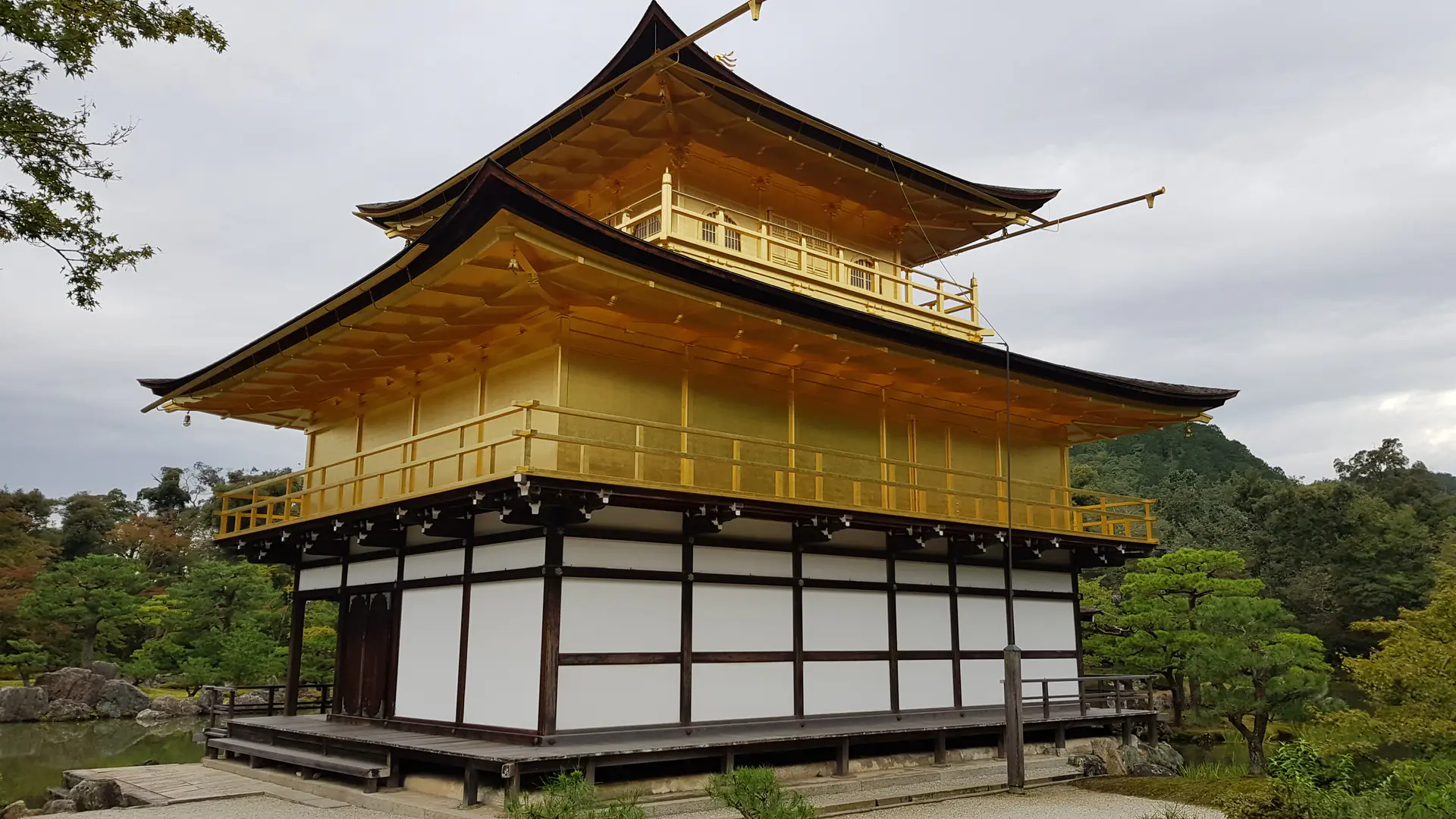
Kinkaku-ji Golden Pavilion Splendour
Experience Japan's most iconic temple, where the upper two floors of a three-story pavilion gleam entirely covered in pure gold leaf. Originally built in 1397 as shogun retirement villa, Kinkaku-ji exemplifies harmony between architecture and nature through stunning reflection in Mirror Pond. The current structure, meticulously rebuilt after 1950 arson, uses gold coating five times thicker than the original, creating dazzling spectacle particularly stunning in autumn when surrounding maples blaze red and gold. Each floor represents different architectural style: Heian aristocratic, samurai, and Zen Buddhist, demonstrating cultural synthesis. The strolling garden features carefully positioned rocks and pine trees creating timeless composition. Bronze phoenix crowning the roof symbolises rebirth and the building's reconstruction. Pro tip: Arrive at 9am opening to photograph the Golden Pavilion reflected in Mirror Pond before tour groups create crowds along the pathway--the one-way circuit means you can't return, so take your time at the first viewpoint where morning light creates the most spectacular golden reflections.
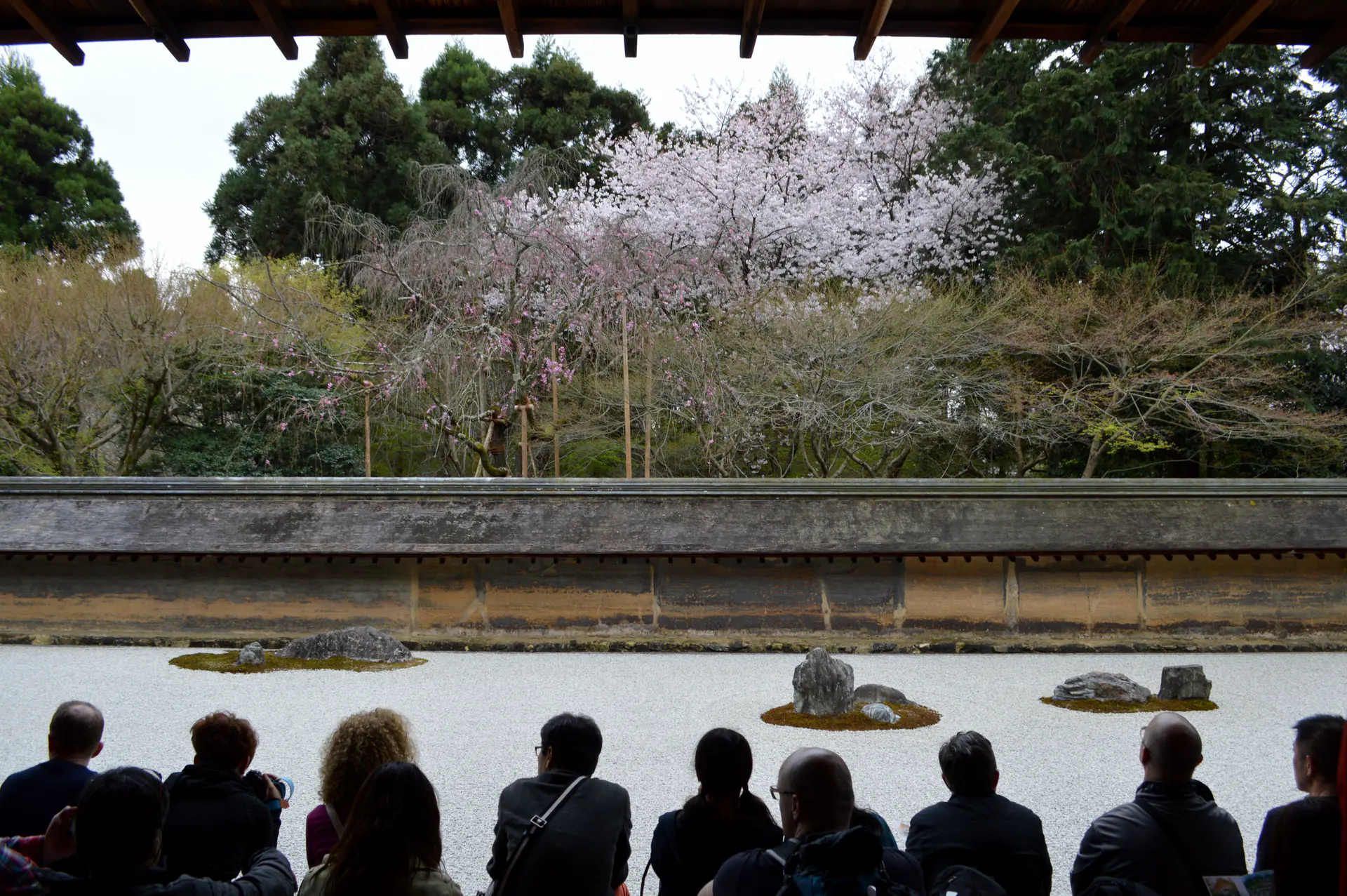
Ryōan-ji Zen Rock Garden Contemplation
Contemplate Japan's most celebrated rock garden, a masterpiece of minimalist design featuring fifteen stones arranged in raked white gravel. Created during the 15th century, this kare-sansui dry landscape represents ultimate refinement of Zen aesthetic principles through deliberate simplicity. The stones are positioned such that from any viewing angle, at least one remains hidden, inviting contemplation about perspective and completeness. Despite countless studies, the garden's precise meaning remains enigmatic, allowing each visitor personal interpretation. The surrounding temple complex features beautiful moss garden and peaceful pond. Visiting at opening time allows solitary appreciation of this profound artistic achievement. The garden's influence on modernist design and Japanese aesthetics extends far beyond temple walls. Pro tip: Visit Ryōan-ji at 8am opening or 4:30pm final hour for solitary contemplation--the famous rock garden becomes crowded and noisy during midday hours when the meditative atmosphere vanishes, but early morning or late afternoon offers the peaceful Zen experience the garden was designed to provide.
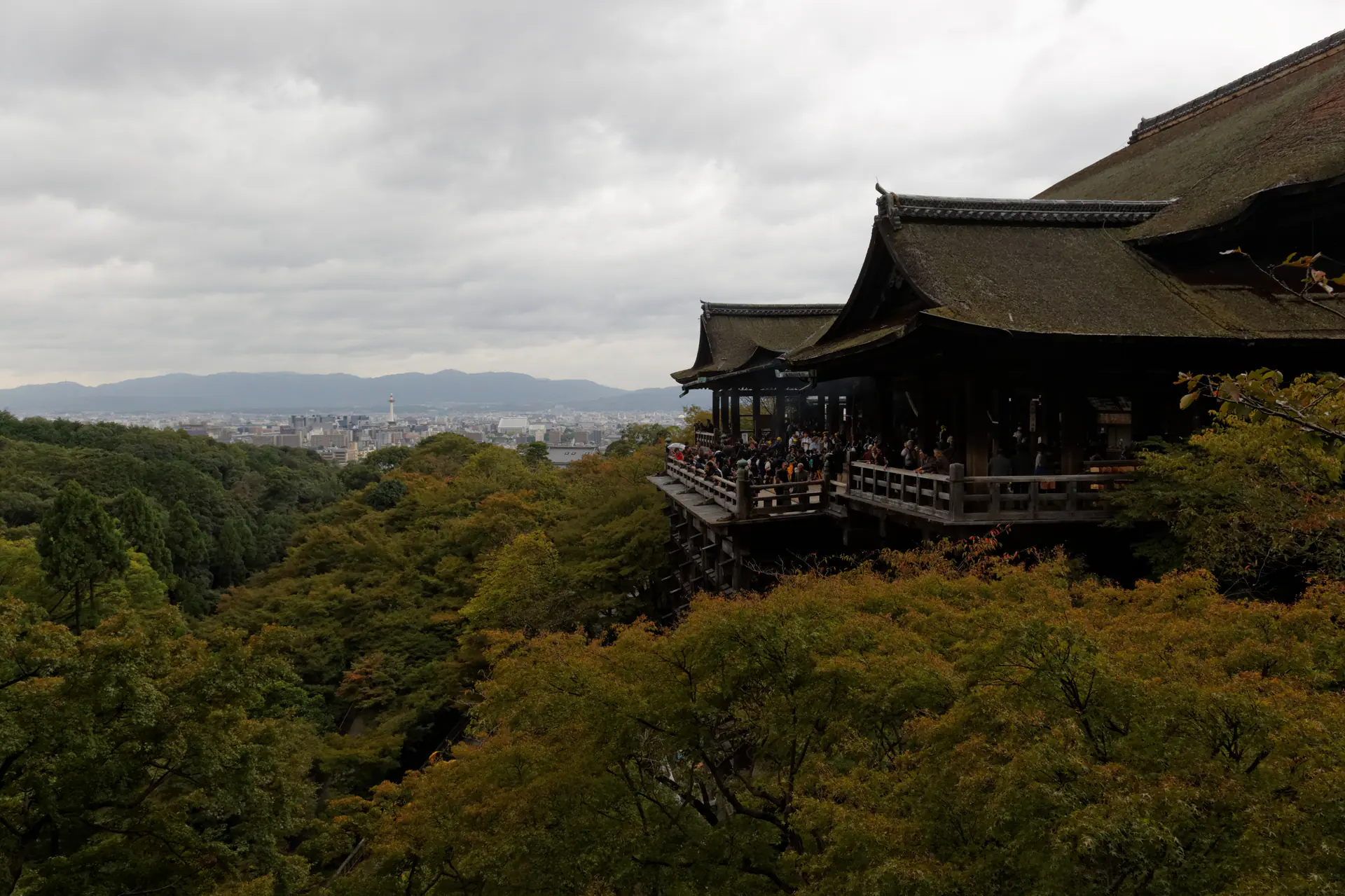
Kiyomizu-dera Wooden Stage Engineering
Marvel at extraordinary wooden stage projecting from Kiyomizu-dera's main hall, supported entirely by massive timber pillars without a single nail. Built originally in 778 and rebuilt multiple times following fires, this architectural achievement demonstrates traditional Japanese carpentry through complex interlocking joinery system. The stage extends thirteen meters above hillside providing spectacular panoramic views across Kyoto cityscape. Cherry and maple trees surrounding the temple create seasonal spectacles with spring blossoms and autumn colors. The Otowa Waterfall below features three streams where visitors drink water for wisdom, health, and longevity. The temple name means 'Pure Water Temple' referencing this sacred spring. Evening illuminations during special seasons transform the hillside into magical landscape of lights and natural beauty. Pro tip: Walk up through the atmospheric Higashiyama district's traditional streets (Ninenzaka and Sannenzaka) to Kiyomizu-dera rather than taking a taxi--the 15-minute uphill stroll through preserved wooden machiya houses, craft shops, and tea houses creates perfect cultural context before experiencing the temple's architectural grandeur.
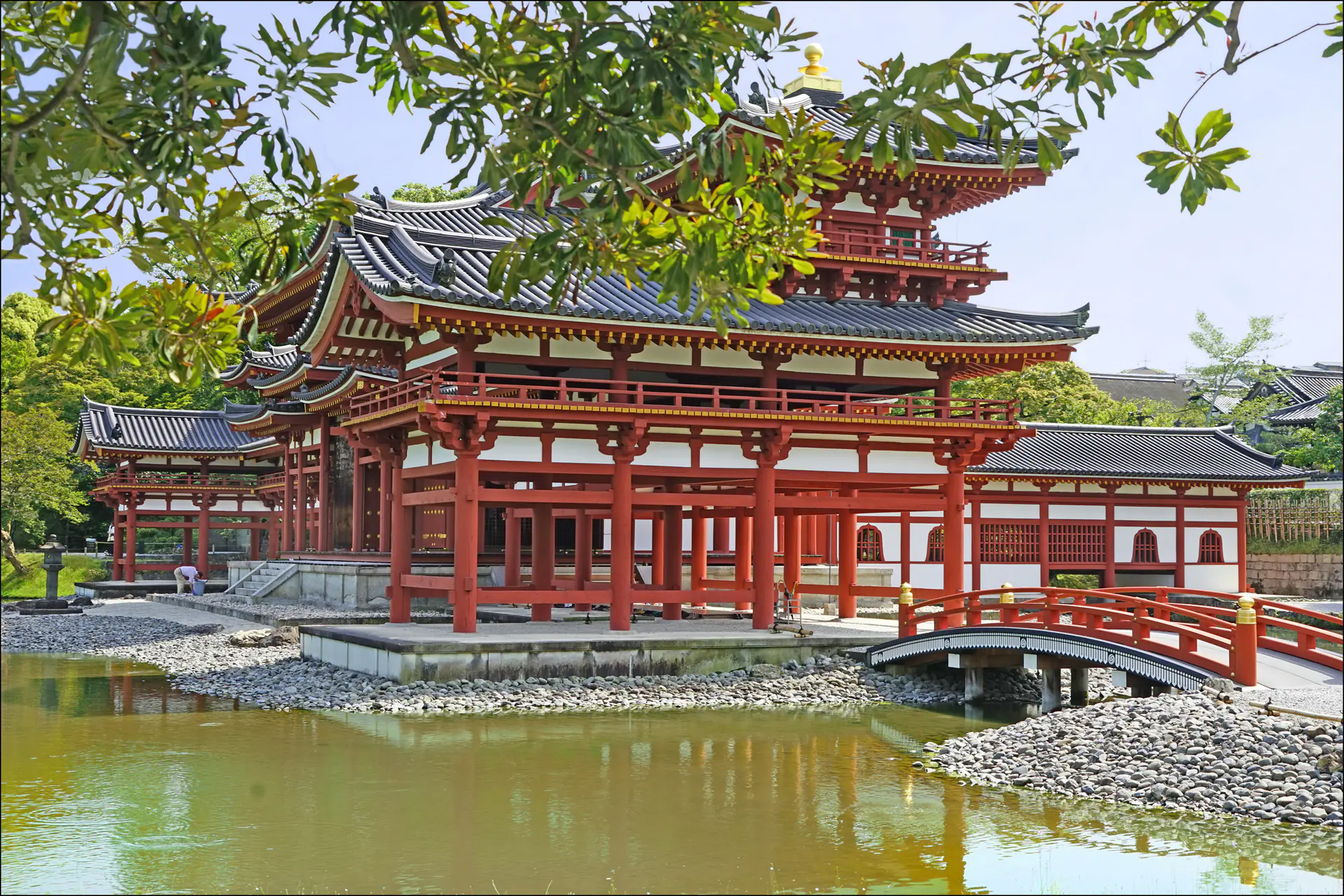
Byōdō-in Phoenix Hall Paradise
Visit magnificent representation of Buddhist Pure Land paradise in architectural form. Built in 1053 in Uji, the Phoenix Hall exemplifies Heian period aristocratic culture through elegant symmetry, graceful rooflines, and bronze phoenixes adorning ridges. The central hall enshrines Amida Buddha surrounded by celestial musicians and bodhisattvas carved in relief, creating vision of Western Paradise. Reflected in pond, the building appears floating above water, enhancing paradise imagery. The structure appears on Japanese 10-yen coins demonstrating national cultural significance. Adjacent museum displays precious phoenix statues and temple bells while explaining Pure Land Buddhism's profound influence on Japanese art and architecture. Morning visits capture beautiful light reflections across pond surface. Pro tip: Take the JR Nara Line to Uji Station (17 minutes from Kyoto) and visit Byōdō-in before returning to central Kyoto temples--this UNESCO site receives far fewer visitors than Kinkaku-ji despite equal cultural significance, and the peaceful pond setting allows serene appreciation of the iconic 10-yen coin building.
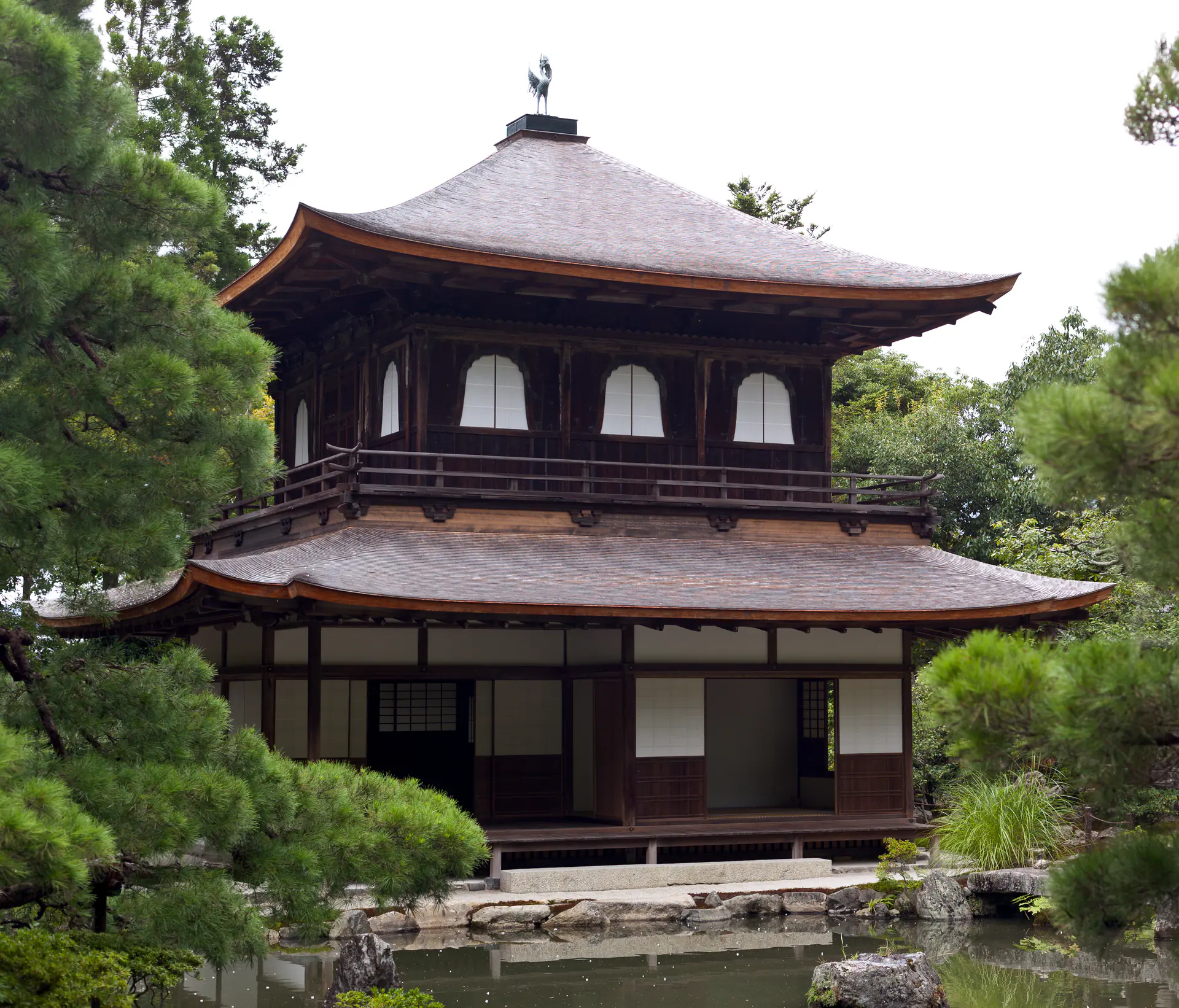
Ginkaku-ji Silver Pavilion Aesthetic
Explore refined aesthetic of Higashiyama culture at Ginkaku-ji, the Silver Pavilion that was never actually covered in silver. Built in 1482 as shogun retirement villa, this Zen temple exemplifies wabi-sabi aesthetic celebrating understated elegance and impermanence. The gardens showcase exceptional design through moss-covered grounds, strolling paths, and distinctive sand features including meticulously shaped cone and raked 'sea of silver sand' creating moonlight reflection effects. The two-story pavilion demonstrates restrained beauty contrasting with Kinkaku-ji's golden opulence. Surrounding hillside garden offers elevated viewpoints revealing garden compositions from multiple perspectives. The temple influenced tea ceremony aesthetics and Japanese minimalist design philosophy continuing to inspire contemporary artists and designers worldwide. Pro tip: Walk the Philosopher's Path from Ginkaku-ji to Nanzen-ji temple (30 minutes along cherry-tree-lined canal)--this contemplative stone walkway connects multiple temples while offering peaceful escape from tourist crowds, especially beautiful during early morning or cherry blossom season when petals float on the water.
Historical Context
Heian Period Capital Foundation (794-1185)
Emperor Kanmu established Heian-kyō (Kyoto) as imperial capital in 794, modeled on Tang capital Chang'an. The city became center of aristocratic culture producing The Tale of Genji. Buddhist temples and Shinto shrines flourished while aristocrats developed refined aesthetic sensibilities through architecture, gardens, poetry, and courtly arts defining classical Japanese culture.
Medieval Period and Zen Buddhism Rise (12th-14th centuries)
Despite military government in Kamakura, Kyoto retained imperial court and remained Japan's cultural heart. Zen Buddhism gained prominence among warriors, profoundly influencing architecture, garden design, and aesthetic principles. Temples including Ryōan-ji developed distinctive Zen garden styles emphasizing minimalism, contemplation, and harmony with nature, synthesising Chinese Chan Buddhism with Japanese sensibilities.
Muromachi Period and Golden Age (1336-1573)
Ashikaga shoguns returned political power to Kyoto, initiating golden age of cultural achievement. Kinkaku-ji and Ginkaku-ji exemplified shogunal arts patronage while tea ceremony, Noh theater, and landscape painting reached artistic heights. Despite Ōnin War devastation (1467-1477), cultural traditions persisted, producing enduring aesthetic principles including wabi-sabi celebrating imperfection and transience.
Edo Period Preservation and Development (1603-1868)
Tokugawa shogunate moved political capital to Edo (Tokyo), yet Kyoto retained imperial court and remained cultural capital. Nijo Castle demonstrated shogunal authority. Despite reduced political importance, Kyoto's temples, shrines, and gardens received continued patronage. Traditional crafts including silk weaving, ceramics, and lacquerware flourished, establishing foundations for modern industries.
Modern Preservation and UNESCO Recognition (1868-present)
Meiji Restoration transferred emperor to Tokyo in 1868, ending Kyoto's political role. The city modernised while preserving cultural heritage. Spared from WWII bombing through US Secretary of War Henry Stimson's intervention, Kyoto retained exceptional architectural legacy. UNESCO designation in 1994 recognized outstanding universal value while balancing preservation with contemporary development.
Conservation
Current Status
The seventeen component monuments maintain good conservation status through dedicated preservation programs and regular restoration using historical techniques. Primary challenges include wooden architecture vulnerability to fire, earthquakes, climate impacts, and mass tourism pressures.
Challenges
- Wooden structure preservation requiring constant maintenance against decay, insect damage, and natural disasters including earthquakes and typhoons
- Mass tourism overwhelming sites with over 80 million annual visitors to Kyoto, causing congestion, infrastructure strain, and impact on contemplative temple atmospheres
- Declining traditional craftsmanship as specialized artisans age without sufficient apprentices learning historic construction and restoration techniques
- Climate change affecting seasonal patterns crucial for garden design while increasing heavy rainfall events and summer temperature extremes threatening wooden structures
Conservation Efforts
- Rigorous fire prevention systems including sprinkler installations, fire watch programs, and strict regulations following historic temple fire incidents
- Traditional craft preservation programs training new generation of carpenters, gardeners, and artisans in historic techniques essential for authentic restoration
- Visitor management strategies including advance booking systems, early morning opening hours, and off-season promotion reducing overcrowding at major sites
- UNESCO monitoring supporting international expertise exchange, conservation funding mechanisms, and buffer zone protections maintaining historic viewsheds and urban character
Frequently Asked Questions
The Historic Monuments of Ancient Kyoto comprise seventeen properties across Kyoto, Uji, and Ōtsu cities including thirteen Buddhist temples, three Shinto shrines, and one castle. These monuments represent Japanese architectural and garden design evolution spanning ten centuries of cultural achievement from Heian to Edo periods.
Kinkaku-ji's gold leaf covering represents shogunal wealth and Buddhist paradise symbolism. Originally built in 1397 for Shogun Ashikaga Yoshimitsu, the golden pavilion exemplifies Pure Land Buddhist aesthetics where gold symbolises enlightenment. Current restoration uses 20 kilograms of gold leaf applied after 1950 reconstruction.
US Secretary of War Henry Stimson removed Kyoto from atomic bomb and firebombing target lists, recognizing its exceptional cultural significance. Having visited Kyoto in 1926, Stimson understood the city's irreplaceable historical importance, ensuring preservation of Japanese architectural heritage that would otherwise have been destroyed.
March through May for cherry blossoms and November for autumn foliage offer spectacular seasonal beauty. Early morning visits provide peaceful atmosphere before crowds arrive. Avoid peak summer humidity in July-August. Winter months feature fewer tourists while maintaining temple beauty and accessibility throughout the year.
Visitors cannot enter Kinkaku-ji pavilion interior as it functions as shariden (Buddha relic hall) not open to public. However, the strolling garden path provides excellent viewing angles for photography and contemplation. Entry fee grants access to beautiful garden grounds surrounding the iconic golden structure.
Individual temple entry costs ¥300-800 ($2-5.30 USD) per site including Kinkaku-ji, Kiyomizu-dera, and Ryōan-ji. Budget travelers spend ¥8,000-12,000 ($53-79 USD) per day. Mid-range visitors pay ¥20,000-35,000 ($132-231 USD) including guided tours and kaiseki dining. Premium experiences cost ¥50,000-100,000+ ($330-660+ USD) with luxury ryokan.
Absolutely - Kyoto preserves seventeen UNESCO monuments spanning 1,000+ years of architectural mastery. Kinkaku-ji Golden Pavilion, Ryōan-ji Zen rock garden, and Kiyomizu-dera showcase exceptional Japanese aesthetics and craftsmanship. Miraculously spared WWII bombing. Book accommodation 3-6 months ahead for cherry blossom and autumn seasons.
Advance booking essential for cherry blossom season (late March-early April) and autumn foliage (November) when accommodation books out 6+ months ahead and prices increase 50-100%. Traditional ryokan inns in Gion and Higashiyama districts fill earliest. Winter and summer allow more flexibility for last-minute bookings.
UNESCO World Heritage Criteria
Inscribed in 1994, this site meets 2 of UNESCO's 10 criteria for Outstanding Universal Value
Criterion (ii): Interchange of human values
The monuments of Ancient Kyoto demonstrate exceptional interchange of human values in Japanese architecture and garden art. As imperial capital for over a thousand years, Kyoto merged Chinese influences with Japanese traditions, creating distinctive architectural styles and aesthetic philosophies that profoundly influenced East Asian culture and landscape design worldwide.
Criterion (iv): Outstanding architectural/technological ensemble
The Historic Monuments of Ancient Kyoto represent outstanding examples of Japanese wooden architecture spanning ten centuries. The seventeen properties exemplify architectural evolution from Heian aristocratic villas through Zen temples to castle architecture, demonstrating exceptional craftsmanship, innovative structural solutions, and refined aesthetic principles characterising traditional Japanese building arts and garden design.
Image & Content Attribution
Research & Content Sources
Photography & Visual Media
Last updated: 2 November 2025